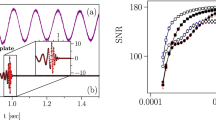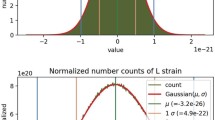Abstract
We present a new event trigger generator based on the Hilbert–Huang transform, named EtaGen (\(\eta\)Gen). It decomposes time-series data into several adaptive modes without imposing a priori bases on the data. The adaptive modes are used to find transients (excesses) in the background noises. A clustering algorithm is used to gather excesses corresponding to a single event and to reconstruct its waveform. The performance of EtaGen is evaluated by how many injections are found in the LIGO simulated data. EtaGen is viable as an event trigger generator when compared directly with the performance of Omicron, which is currently the best event trigger generator used in the LIGO Scientific Collaboration and Virgo Collaboration.







Similar content being viewed by others
Notes
Here, we describe a mode to be adaptive if it is determined during the decomposition process to depend on the original time series data as opposed to the mode that is determined by a predefined basis set.
References
Abbott, B. P., et al.,(Virgo, LIGO Scientific) 2016a. Characterization of transient noise in Advanced LIGO relevant to gravitational wave signal GW150914. Class. Quant. Grav. 33 (13), 134001. https://doi.org/10.1088/0264-9381/33/13/134001arXiv:1602.03844
Abbott, B. P., et al.,(Virgo, LIGO Scientific) 2016b. GW150914: Implications for the stochastic gravitational wave background from binary black holes. Phys. Rev. Lett. 116 (13), 131102. https://doi.org/10.1103/PhysRevLett.116.131102arXiv:1602.03847
Abbott, B. P., et al.,(Virgo, LIGO Scientific), 2016c. GW151226: Observation of Gravitational Waves from a 22-Solar-Mass Binary Black Hole Coalescence. Phys. Rev. Lett. 116 (24), 241103. https://doi.org/10.1103/PhysRevLett.116.241103arXiv:1606.04855
Abbott, B. P., et al.,(LIGO Scientific) 2017a. Exploring the Sensitivity of Next Generation Gravitational Wave Detectors. Class. Quant. Grav. 34 (4), 044001. https://doi.org/10.1088/1361-6382/aa51f4arXiv:1607.08697
Abbott, B. P., et al.,(VIRGO, LIGO Scientific) 2017b. GW170104: Observation of a 50-Solar-Mass Binary Black Hole Coalescence at Redshift 0.2. Phys. Rev. Lett. 118 (22), 221101. https://doi.org/10.1103/PhysRevLett.118.221101arXiv:1706.01812
Abbott, B. P., et al.,(Virgo, LIGO Scientific) 2017c. GW170814: A Three-Detector Observation of Gravitational Waves from a Binary Black Hole Coalescence. Phys. Rev. Lett. 119 (14), 141101. https://doi.org/10.1103/PhysRevLett.119.141101arXiv:1709.09660
Abbott, B. P., et al.,(Virgo, LIGO Scientific), 2017d. GW170817: Observation of Gravitational Waves from a Binary Neutron Star Inspiral. Phys. Rev. Lett. 119 (16), 161101. https://doi.org/10.1103/PhysRevLett.119.161101arXiv:1710.05832
Abbott, B. P., et al.,(LIGO Scientific, Virgo) 2018. GWTC-1: A Gravitational-Wave Transient Catalog of Compact Binary Mergers Observed by LIGO and Virgo during the First and Second Observing Runs. arXiv:1811.12907
J.B. Camp, J.K. Cannizzo, K. Numata, Application of the Hilbert–Huang transform to the search for gravitational waves. Phys. Rev. D 75, 061101 (2007). https://doi.org/10.1103/PhysRevD.75.061101. arXiv:gr-qc/0701148
Faltermeier, R., Zeiler, A., Keck, I. R., Tomé, A. M., Brawanski, A., Lang, E. W., July 2010. Sliding empirical mode decomposition. In: The 2010 International Joint Conference on Neural Networks (IJCNN). pp. 1–8. https://doi.org/10.1109/IJCNN.2010.5596536
R. Faltermeier, A. Zeiler, A.M. Tomé, A. Brawanski, E.W. Lang, Weighted sliding empirical mode decomposition. Adv. Adapt. Data Anal. 03(04), 509–526 (2011). https://doi.org/10.1142/S1793536911000891
P. Flandrin, G. Rilling, P. Goncalves, Empirical mode decomposition as a filter bank. IEEE Signal Process. Lett. 11(2), 112–114 (2004). https://doi.org/10.1109/LSP.2003.821662
N.E. Huang, S.S.P. Shen, Hilbert-Huang Transform and Its Applications. WORLD SCIENTIFIC (2005). https://doi.org/10.1142/5862
N.E. Huang, Z. Shen, S.R. Long, M.C. Wu, H.H. Shih, Q. Zheng, N.-C. Yen, C.C. Tung, H.H. Liu, The empirical mode decomposition and the Hilbert spectrum for nonlinear and non-stationary time series analysis. Proc. R. Soc. Lond. A 454(1971), 903–995 (1998). https://doi.org/10.1098/rspa.1998.0193
N.E. Huang, M.-L.C. Wu, S.R. Long, S.S. Shen, W. Qu, P. Gloersen, K.L. Fan, A confidence limit for the empirical mode decomposition and Hlbert spectral analysis. Proc. R. Soc. Lond. A 459(2037), 2317–2345 (2003). https://doi.org/10.1098/rspa.2003.1123
N.E. Huang, Z. Wu, A review on hilbert-huang transform: method and its applications to geophysical studies. Rev. Geophys. 46(2), RG2006 (2008). https://doi.org/10.1029/2007RG000228
M. Kaneyama, K.-I. Oohara, H. Takahashi, Y. Sekiguchi, H. Tagoshi, M. Shibata, Analysis of gravitational waves from binary neutron star merger by Hilbert–Huang transform. Phys. Rev. D 93(12), 123010 (2016). https://doi.org/10.1103/PhysRevD.93.123010
McIver, J. L., 2015. The impact of terrestrial noise on the detectability and reconstruction of gravitational wave signals from core-collapse supernovae. Ph.D. thesis, Massachusetts U., Amherst
Nuttall, L., Massinger, T. J., Areeda, J., Betzwieser, J., Dwyer, S., Effler, A., Fisher, R. P., Fritschel, P., Kissel, J. S., Lundgren, A. P., Macleod, D. M., Martynov, D., McIver, J., Mullavey, A., Sigg, D., Smith, J. R., Vajente, G., Williamson, A. R., Wipf, C. C., Improving the data quality of advanced ligo based on early engineering run results. Classical and Quantum Gravity 32 (24), 245005
Rousseeuw, P. J., Croux, C., Alternatives to the median absolute deviation. J. Am. Statistical Assoc. (424). https://doi.org/10.2307/2291267
K. Sakai, K.I. Oohara, H. Nakano, M. Kaneyama, H. Takahashi, Estimation of starting times of quasi-normal modes in ringdown gravitational waves with the Hilbert-Huang transform. Phys. Rev. D96(4), 044047 (2017). https://doi.org/10.1103/PhysRevD.96.044047. arXiv:1705.04107
A. Stroeer, J. Camp, Ninja data analysis with a detection pipeline based on the Hilbert–Huang Transform. Class. Quant. Grav. 26, 114012 (2009). https://doi.org/10.1088/0264-9381/26/11/114012. arXiv:0903.2026
A. Stroeer, J.K. Cannizzo, J.B. Camp, N. Gagarin, Methods for detection and characterization of signals in noisy data with the Hilbert–Huang transform. Phys. Rev. D 79, 124022 (2009). https://doi.org/10.1103/PhysRevD.79.124022. arXiv:0903.4616
G. Valdes, B. O’Reilly, M. Diaz, A Hilbert–Huang transform method for scattering identification in LIGO. Class. Quant. Grav. 34(23), 235009 (2017). https://doi.org/10.1088/1361-6382/aa8e6b
G. Wang, X.-Y. Chen, F.-L. Qiao, Z. Wu, N.E. Huang, On intrinsic mode function. Adv. Adapt. Data Anal. 02(03), 277–293 (2010). https://doi.org/10.1142/S1793536910000549
Z. Wu, N.E. Huang, Ensemble empirical mode decomposition: a noise-assisted data analysis method. Adv. Adapt. Data Anal. 01(01), 1–41 (2009). https://doi.org/10.1142/S1793536909000047
Acknowledgements
The authors would like to thank Jay Tasson for helpful comments and suggestions and Chris Pankow for letting us use the simulated GW data. EJS is grateful to Hyoungseok Chu for the fruitful contribution to the early stage of this work. This work was supported by Basic Science Research Program through a National Research Foundation of Korea (NRF) funded by the Ministry of Education (NRF-2020R1I1A2054376, and NRF-2018R1D1A1B07041004). This work is partially supported by the NRF grant funded by the Korea government’s Ministry of Science and CIT (No. 2019R1A2C2006787, No. 2016R1A5A1013277, and No. 2019R1C1C1010571). LIGO was constructed by the California Institute of Technology and the Massachusetts Institute of Technology with funding from the National Science Foundation and operates under cooperative agreement PHY-0757058. This paper carries LIGO Document Number LIGO-P1800294.
Author information
Authors and Affiliations
Corresponding authors
Additional information
Publisher's Note
Springer Nature remains neutral with regard to jurisdictional claims in published maps and institutional affiliations.
Rights and permissions
About this article
Cite this article
Son, E.J., Kim, W., Kim, YM. et al. Time series anomaly detection for gravitational-wave detectors based on the Hilbert–Huang transform. J. Korean Phys. Soc. 78, 878–885 (2021). https://doi.org/10.1007/s40042-021-00094-2
Received:
Accepted:
Published:
Issue Date:
DOI: https://doi.org/10.1007/s40042-021-00094-2




